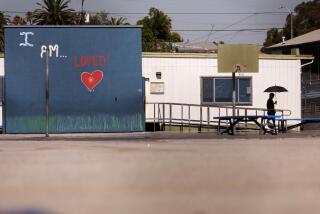Brighter in the Daylight
- Share via
Want higher test scores from students? Let there be daylight.
Students who work in classrooms bathed in sunlight learn faster and score higher on standardized tests than their artificially-lit peers, according to a recent study conducted in south Orange County and two other areas.
Elementary students in classrooms with more natural illumination scored up to 26% higher on standardized tests in reading and up to 20% higher in math, the study found.
State and federal education and energy officials describe the findings as a credible and intriguing confirmation of a long-standing hunch: Students and teachers feel and perform better in classrooms with large windows or good skylights. The study, conducted by an energy consulting firm, was one of the largest ever conducted on the relationship between daylight and student performance.
Even before the study’s release, school architects had been returning to airier classroom design after years of building temperature-controlled spaces with small windows and flickering fluorescent lights. If planned follow-up studies on natural light confirm the findings, the state plans to advise all public schools to take heed as they plan new campuses or revamp old ones.
“It’s a very well-done study, and it correlates with a number of other studies that have been done indicating that lighting is a key element,” said John B. Lyons, the educational facilities program manager for the federal Education Department.
Among the 21,000 elementary students studied were more than 8,200 pupils in the Capistrano Unified School District, where lighting conditions run the gamut from darkly tinted windows to schools awash in a natural glow from skylights. In the fast-growing district, many of the classrooms are portable ones, where teachers tend to compensate for small windows by leaving doors open to bring in more light and air, the researchers found.
The differences in the Capistrano students’ scores were striking. Children with the most sunlight scored 20% higher in math tests and 26% higher in reading than those most deprived of natural light.
Likewise, students in classes with the largest windows progressed 15% faster in math and 23% faster in reading than those with the smallest windows. Similar growth was observed for students in rooms with well-designed, easy-to-adjust skylights.
Students in the other two areas studied--Seattle and Fort Collins, Colo.--also showed consistently better scores in sunlit classes, but to a lesser degree than in Capistrano.
No one knows for sure why sunlight has such a strong tie to student achievement, but the study’s authors have some theories. They believe that the light is probably a mood lifter for students and teachers alike. Sunlight might also boost overall health, and may make it easier for students to see their books and blackboards.
Arroyo Vista second-grader Jack Wilson tends to agree with that last theory.
“I like the [skylight] because it gives me more light,” the 8-year-old opined. “If it’s dark, things look all globbely.”
The study, which was peer-reviewed, made sure that student demographics and several other factors did not have an effect on the findings. But one thing remains unclear: Are better teachers somehow finding their way to sunnier classrooms?
“We have been assured by teachers, principals and administrators that they don’t believe this is happening,” said study author Lisa Heschong, “but we’re going to go back and see.” Her company, the Heschong Mahone Group in Fair Oaks, Calif., conducted the research for the state’s Energy Efficiency Board and Pacific Gas and Electric Co.
*
The research comes as Californians increasingly demand improved school achievement and as the nation copes with record school enrollment. Last year alone, the country spent $22.9 billion on school construction--almost $2 billion in California. Those numbers are expected to taper off only slightly in the next two years, according to federal estimates.
The state education department’s director of facilities has taken a shine to the research. If Heschong can find a way to answer the teacher quality measure, director Duwayne Brooks said he plans to send a bulletin advising all school districts to be more conscious of lighting conditions as the state undertakes massive building and renovation projects.
“I certainly think I work better” in natural light, Brooks said. “I think, when you look at who gets the windows and the corner offices, those are usually plum spaces for those who have seniority.”
But some people are taking a dimmer view of the research, including principal Silvia Pule. Her school--Capistrano’s San Juan Elementary, an older school with partially tinted windows to reduce glare--was part of the study.
“I know I personally enjoy natural light,” she said. “But I doubt that we could attribute a difference in scores to that. . . . I’d be curious to see the same students in a different environment--otherwise, how can you attribute the difference to natural lighting. There are so many other reasons why a student might not perform as well--it could be [learning a second] language, which would be first in my mind.”
But the study’s authors maintain that they controlled for such factors. In their examination of daylight and performance, the researchers hired statisticians to eliminate the influence of other variables. They examined student scores from Capistrano districtwide tests taken at the beginning and end of each school year and annual test results from the other districts.
After visiting classrooms and asking experts on light to look at classroom plans, the authors ranked each classroom on a scale of zero to five based on the overall light from windows. A five meant the room could be adequately lit for most of the year using window light alone. A zero meant a classroom devoid of windows. A similar scale was crafted for overall daylight--including skylights.
More to Read
Sign up for Essential California
The most important California stories and recommendations in your inbox every morning.
You may occasionally receive promotional content from the Los Angeles Times.













